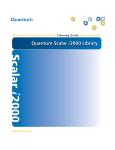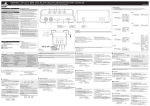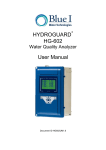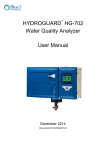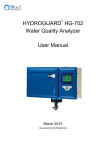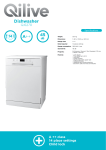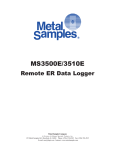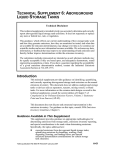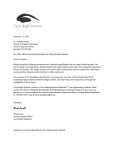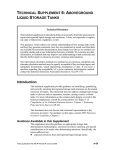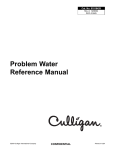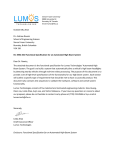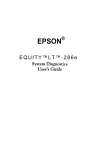Download Water System Assessment User's Guide: Appendices
Transcript
Water System Assessment User’s Guide: Appendices Version 1.0 May 4, 2012 Health Protection Branch B.C. Ministry of Health Appendices V 1.0 Contents 1 2 3 Appendix A: Guidance to Answering Questions in the Hazard Assessment ......................................... 1 1.1 Ownership and Management Structure (Governance) ................................................................ 1 1.2 Drinking Water Source .................................................................................................................. 1 1.3 Water System Elements ................................................................................................................ 7 1.4 Water Quality and Quantity ........................................................................................................ 13 1.5 Water System Operation ............................................................................................................ 14 1.6 Finances ...................................................................................................................................... 17 Appendix B: Useful Resources ............................................................................................................ 19 Appendix C: Glossary .......................................................................................................................... 20 ii Water System Assessment User’s Guide: Appendices v 1.0 May 4, 2012 1 Appendix A: Guidance to Answering Questions in the Hazard Assessment 1.1 Ownership and Management Structure (Governance) 1.1.1 Accountability Level Who is accountable for providing safe drinking water? Consider the following: • • • Is one person named as a contact for the water system? Is the water system governed by a strata council and no single individual is accountable for providing safe drinking water? Is there a lack of accountability that can lead to poor management practices and create a health risk? Note: If the owner(s) of the water system do not choose a contact, the drinking water officer can choose a person or persons to be a contact for exchanging information on the water system, including the communication of threats. 1.1.2 Governance Decisions The purpose of the water system is to provide safe, potable water. Water quality and quantity should govern decisions. With this in mind, consider the following: • • • • • • • • Are decisions based on water quality delivered and quantity needs? Are improvements needed in policies, governance decisions and/or communication to operational staff? Is management focused on quality service? Is the health and safety of the operator and customers a top priority? Is there support for repairs, short‐ and long‐term planning, and training? Are drinking water management practices effective? Is the water supply system assessed regularly? Is the emergency response plan kept current? Note: Emergency response plans function as the last barrier in emergency or abnormal operating situations. They are required under Section 13 of the Drinking Water Protection Regulation. Contact phone numbers and information must be current for the plan to be effective. 1.2 Drinking Water Source Before you can protect your water, you need to familiarize yourself with the land area that contributes to the water source. This is your source capture area. Characteristics of the land itself (topographical features, vegetation) and activities on the land (industry, agriculture) can affect source water quality and availability. Deciding on a practical assessment area in which to analyze influences on your water source will help you to look for contaminants and other hazards within that area. To complete the following assessment, you may want to walk the land and refer to recent photographs, topographical maps and other documents. Make careful observations and record details as completely as possible. 1 Water System Assessment User’s Guide: Appendices v 1.0 May 4, 2012 Appendices V 1.0 1.2.1 Location and Characteristics Is the source capture area stable and secure? Take a wide look around the source capture area for the following conditions: • • • • • • • • • • • • • • Potential for land or snow slides High precipitation or flooding, or disruption from ice buildup. Large amounts of debris that might enter a surface water intake or increase turbidity Current industrial operations Transmission or pipeline right‐of‐ways Above‐ or below‐ground chemical storage Source capture area downstream of known or potential physical threats Source capture area immediately upstream or upslope of activities that could lower the ground water table (e.g., construction, gravel extraction that could destabilize stream conditions) Mining or seismic activities that may fracture and disturb the aquifer in a hard rock area and change ground water quality and quantity Proposed large construction or development projects, including logging and mining Structures such as roadways or a dam that could affect your water source if they fail Potential for wells or intakes to be hit or disturbed by construction or service vehicles Intake structures near areas of current or potential bank erosion Potential for unauthorized access/entry to waterworks facility Review the overall source area to determine if protection is adequate for anticipated risks. 1.2.2 Water Source Contamination 1.2.2.1 Agriculture and Wildlife Are there pastures, feedlots, or extensive wildlife impacts in the water source capture area? Is there a potential for fecal material and other likely contaminants to impact your water source? Domestic animals and wildlife are hosts for pathogens such as Giardia and Cryptosporidium. Consider the following: • • • • • 1.2.2.2 Nearby presence of concentrated agricultural use (cattle feedlot, hog farm or large poultry operation) Cattle in pasture or at large (Note if they access surface water to drink.) Stored manure or manure application Wildlife such as seasonal bird concentrations Wildlife populations of deer, bear, beaver, ducks, geese, cougars, etc. Forestry and Highways Is there a potential for forestry and highways activities to impact on your water source? Communicate with agencies, companies, and contractors so that they are aware of their potential effect on your drinking water quality and to discuss resolution of any hazards. Consider the following: • • • • • Pesticide application Hydrocarbon sources, including oil spills Leachate, including road salts Erosion from road construction and maintenance Runoff turbidity from road sediment. 2 Water System Assessment User’s Guide: Appendices v 1.0 May 4, 2012 Appendices V 1.0 1.2.2.3 Resource Development Do oil and gas, mining, sawmills, and/or wood‐preserving stockpiles impact your water source? Consider the historical, current, and future (proposed) activity for hazards: • • • • • Oil and gas development Mining Sawmills Wood preserving Recreational sources Will boating, swimming and/or camping activities impact your water source? The potential for contamination is affected by the number of people, the type of facility, the dilution factor and the distance to the water source. Discuss potential and actual hazards with the owner or agency of the recreational areas. The primary hazard from boating, swimming and camping in undeveloped campgrounds is human waste. Contamination concerns from boating on the larger, more popular lakes in British Columbia are affected by controls on holding tanks and the provision of pump out facilities. Consider the following: • • • • • 1.2.2.4 Lack of adequate privies for undeveloped camping areas. Privies should be constructed at least 30 metres (100 feet) from any surface water and at least 1 metre (4 feet) above the water table Developed campgrounds may be a source of human waste near your water source. Campgrounds should have appropriate greywater pits. Swimming contamination can come from human feces, human body oil, and cosmetics such as sunscreen, body lotion, soap and shampoo. Boating contamination includes petroleum contamination and human waste. Residential /Urban Activities Will urban activities such as the application of lawn fertilizers, domestic pets, developed and undeveloped parks, and surface runoff impact your water source? Rainfall and flooding can cause surface area contamination to travel from residential and park properties with the stormwater runoff. Consider how the following contamination sources can affect your water quality: • • • • 1.2.2.5 Application of pesticides Application of fertilizers Pet fecal matter on private properties Contaminated water from vehicle washing Municipal Infrastructure Do municipal storm runoff, sewage treatment or landfill discharge impact your water source? Storm sewers collect a wide variety of contaminated material and often drain directly into watercourses. Consider how the following contamination sources can affect your source water quality: • • • • • Septic systems on your property and/or neighbouring ones Stormwater runoff during rainfall or flooding Parks, roadways or large paved areas Sewage treatment discharge or spills Landfill leachate 3 Water System Assessment User’s Guide: Appendices v 1.0 May 4, 2012 Appendices V 1.0 1.2.2.6 Commercial Sources Do airports, service stations, marinas, car washes impact your water source? Consider contamination sources upslope of your water source: • • • • • 1.2.2.7 Service stations with fuel spillage, perhaps historical leakage Car washes (cleaning compounds and contaminants washed off the vehicles) Golf courses (fertilizer, pesticides, turbidity and human waste) Marinas (availability of pump out facilities, public washrooms and attention to petroleum contaminates) Airports (pesticides and fertilizers, may be discharging high levels of nitrates to the ground surface due to runway de‐icing) Industrial Sources Do railroads, manufacturing, or material stockpiles impact your water source? Threats of an industrial nature can be a serious concern for a water system, depending on the type of risk exposure and the proximity to the water source. Each industry has its unique contaminants and requires different responses to reduce the health risk. Look at the potential for affecting your water system, including the potential for contamination if the safeguards fail: • • • • 1.2.2.8 Manufacturing processes Railroads Material stockpiles Line sources of contamination potential such as sewer lines, fuel pipelines, highways and power lines Paints, Herbicides and Toxic Waste Do spills or unscheduled discharges impact the water source? The potential threat from paints, herbicides and toxic waste from the surrounding area may be difficult to assess. Walk the area and take photos of potential source areas. Perhaps visit the neighbouring properties and discuss concerns, if they are within the source area. It is important that your neighbours are aware of their effect on your drinking water source quality. During your observations, include a look inside the water system structures. Are any of these hazards being stored near your water source? • • • 1.2.2.9 Paints Herbicides Toxic wastes Naturally Occurring Sources Is the water source showing signs of high physical impurity such as suspended solids or high concentrations of chemicals? The potential for erosion and bank instability can cause serious turbidity concerns. Unless it is filtered, particulate matter can reduce the effectiveness of disinfection, potentially causing illness if pathogens are present. • • Consult historical and current lab test results for high levels of physical impurities or concentrations of chemicals. If a lab test confirms high physical impurities or chemical concentrations, ensure these factors have been or are currently being investigated. 4 Water System Assessment User’s Guide: Appendices v 1.0 May 4, 2012 Appendices V 1.0 • • • Check for naturally occurring high levels of chemicals such as arsenic or nitrates If applicable, note how close the ocean is to a well source (may cause high sodium levels) Note seasonal turbidly levels over 1.0 NTUs, which indicate the presence of suspended particulate matter such as sediment, organic material, and microorganisms. 1.2.2.10 Potential Influence within 30 Metres (100 Feet) What is the potential for contamination within 30 metres (100 feet) of the source? This area is usually the most vulnerable because contaminations here are more likely to find their way into your water source than those farther away (but not always). Consider all possible sources of contamination: • • • • • • • • • • Naturally occurring sources Septic field on or near your property Other wells or abandoned wells Potential for spills (oil or other contaminants) Pesticide application Chemical storage Agriculture/livestock activity Potential for contamination from risky products that may be stored in facility structures (oils, gasoline, pesticides, cleaning compounds) Rotting logs or wood piles that shelter rodents or insects, and trees or thick vegetation that shed leaves, which could clog and plug intake structures Standing water, ponds and low‐lying marshy areas Note: For wells, the Health Act’s Transitional Regulation (2011) requires setbacks to: • • • Any source of contamination of 30 metres (100 feet) Any private dwelling of 6 metres (20 feet) Any cemetery or dumping ground of 122 metres (400 feet) 1.2.2.11 Potential Influence within 100 Metres (330 feet) What is the potential for contamination within 100 metres (330 feet) of the source? Walk the area and take photos for your records of potential and actual hazards. Consider the public health issues related to drinking water: • • • • • • • • • Naturally occurring sources Other wells or abandoned wells Sewage disposal system on this or nearby properties Agriculture/livestock activity Rotting logs or wood piles that shelter rodents or insects Trees or thick vegetation that shed leaves and debris to clog intake structures Access roads/vehicle contamination (oil/gas spillage, road debris from erosion) Potential for unauthorized recreational activities (snowmobiling, boating, fishing) Standing water, ponds and low‐lying marshy areas 5 Water System Assessment User’s Guide: Appendices v 1.0 May 4, 2012 Appendices V 1.0 1.2.2.12 Potential Influence beyond 100 metres (330 feet) What is the potential for contamination beyond 100 metres (330 feet) of the source? Who owns or controls the aquifer or watershed area? If the land use is limited or controlled by a government agency, there may be regulated protection for water supplies. If land use is uncontrolled and there is a potential risk of drinking water contamination, you may need to increase your protection measures and possibly treatments, or even change your source. Wells are affected by the land area supplying the aquifer. Surface waters are supplied by precipitation falling from the height of land draining to the intake. Are there activities in this wider area with a potential for contaminating the aquifer or surface water? Use topographical maps available from a variety of sources, including print and online. Consider the natural characteristics of the land (vegetation, topography, soils). Consider the historical, current, and future (proposed) land uses and their effect on drinking water quality and quantity. Note the presence of these and any other hazards: • • • • • • • • • • • • • • Naturally occurring sources Seasonal algal blooms Salt water intrusion into a coastal aquifer Naturally occurring contaminants such as arsenic or uranium Potential for downslope contamination from nearby roadways (spillage, road debris) Recreational activities, either legal or trespass (snowmobiling, boating) Storage of potentially harmful materials above or below ground (chemicals, fertilizers, pesticides and herbicides) Landfill or refuse storage Storage or application of manure Impacts from livestock (cattle, horses, sheep, poultry) Impacts from wildlife (deer, moose, beaver, bear, waterfowl) High‐density residential areas with onsite sewage‐disposal systems Intensive agriculture (commercial vegetable growing, nurseries, orchards, feed lots) Major highway, railway, pipeline Reminder: For wells, the Health Act’s Transitional Regulation (2011) requires setbacks to: • • • Any source of contamination of 30 metres (100 feet) Any private dwelling of 6 metres (20 feet) Any cemetery or dumping ground of 122 metres (400 feet) 1.2.3 Intake Contamination: Surface System This section is not detailed as the previous section, since the questions are more specific and deal less with abstract concepts requiring further explanation. However, many of the points covered in this section can draw from the guidance in the previous section. 1.2.3.1 Sanitary Condition and Location of Source Capture How clean and safe from contaminants is the source capture area? What impact will the unsanitary conditions have on the risk to the water system? Consider the following conditions: • Upstream or upslope development, especially on alluvial fans that can funnel poorly treated sewage effluent and nitrates towards your water source. 6 Water System Assessment User’s Guide: Appendices v 1.0 May 4, 2012 Appendices V 1.0 • • • • • • • • • • • 1.2.3.2 Evidence of rodents or other pests (observe buildings for tunneling access or insect infestation) Screened venting Potential for access from domestic animals and wildlife Potential for unauthorized visitors, including for recreational activities Potential for flooding or surface ponding Potential for surface water to channel into well (located in fractured bedrock) Available well log describing ground qualities, especially the presence of impermeable clay, silt, or till‐soil lenses for ground water protection Quality of well construction. The following are recommended: o Well has a surface seal o Sanitary well cap o Grade sloping up to the casing o No gap between the well casing and the surrounding ground o Secure well house Quality of water intake construction. The following are recommended: o A variable level pickup screen to get the best available source water quality in different seasons and conditions o An overflow to divert large debris o Screening from airborne and waterborne organic material such as leaves and other organic vegetation Written ground water protection plan for this well, based on the Well Protection Toolkit or something comparable Written watershed protection plan for this surface source that considers drinking water Impact of Changes in Climate and/or Ground Water Table Is your water source vulnerable to changes in the climate or ground water table? Climate change is affecting different parts of the province differently. Realistically decide on the impact that this will likely make to your raw water supply and steps to reduce the risk to the water system. Consider the following: • • • • • • • • Historical levels of precipitation, current levels and forecast levels for a 20‐year period If available, recorded ground water levels over time Risk of drought Risk of flooding Potential of concentration of contamination levels of bacteriological and chemical parameters in the source water Well less than 15 metres (50 feet) deep, which could run dry Well located less than 30 metres (100 feet) from surface water, which has the potential for direct influence on the ground water Other wells, including abandoned ones that could allow access to contaminants 1.3 Water System Elements Once you have protected your water source, you will need to keep the water protected as it moves through your water system on its way to the end users. This section identifies the potential for water quality concerns from the water source, through treatment, storage, distribution and the overall facility. A logical approach is to follow the water through the supply system from source to tap, identifying all hazardous activities, processes or conditions that could influence water quality or quantity. 7 Water System Assessment User’s Guide: Appendices v 1.0 May 4, 2012 Appendices V 1.0 We recommend you gather together and review past water‐system‐inspection reports, maintenance records, as‐built drawings, and other documentation of any previous problems or concerns. Focus on concerns with the greatest implications for public health. Your documentation should include: • • • A description of the water supply system and elements: o Components, processes, number of connections and history (age and dates of upgrades) o Condition, suitability and security of each element Supporting documentation: o Well logs, equipment specifications/manuals, drawings and photographs to corroborate observations A schematic diagram of water supply system and its elements, as in Figure 1, below. Figure 1: Example of a Schematic Drawing 1.3.1 Storage Facilities Is the water storage capacity adequate at the present time? Will lack of capacity and/or integrity impact the system? Consider the following: • • • • • • • Do pressure tanks have the storage capacity to meet peak demand? Is there adequate storage capacity – for both raw and finished water – to meet peak demand? Does the storage capacity meet the required minimum of one day’s maximum demand? Can the reservoir be isolated from the system for maintenance or in case of contamination? Are storage facilities are in a sanitary condition, organized and well maintained? Are overflow lines, vent pipes, drain lines and cleanout pipes turned downward and screened for rodent and insect protection? Do the storage tanks include design features that encourage adequate daily water turnover, water circulation, reduce stagnation and chlorine decay 8 Water System Assessment User’s Guide: Appendices v 1.0 May 4, 2012 Appendices V 1.0 1.3.2 Supply and Distribution Pumps Do pump age, capacity, condition adversely impact delivery of water? Consider the following: • • • • • • Can units be bypassed to cause a cross‐connection (hazard)? Are supply pumps properly installed? Are pitless adaptors (well pumps) installed? Can the supply pump meet the maximum daily flow demand (treatment design flow)? Can distribution pumps meet peak hourly flow and pressure requirements? Are control valves in working order and well maintained? 1.3.3 Distribution System Piping and Pressure Will pipe type, condition and/or size limit the ability to supply adequate quantities of water? Deterioration can lead to increased leaks, breakages and corrosion, possibly impairing water quality following treatment. Badly corroded pipes can increase regrowth in the pipes, especially at joints, and may require changes in pipe size and valves. Identify any changes needed to reduce the impacts on the water system. Consider the following: • • • • • • • • • • • • • • • • • Do the type, condition and size of the pipe meet NSF/ANSI 61, AWWA or CSA standards? Are pipes constructed of approved material? Are distribution mains adequately sized to supply flow and pressure (during fire flow conditions where applicable)? Are all pipes in good condition? Are there sufficient back‐flow prevention valves in the system to protect the water supply from water users involved with hazardous chemicals – such as laundromats, photographic labs, hospitals and commercial filter cleaning operations? Is there a potential for impaired water quality due to internal corrosion of unlined metallic components or poor maintenance practices? Is there a high leakage rate due to corrosion or leaking joints? Are there frequent breaks due to corrosion, material degradation or operating conditions (check the maintenance log)? Does the floor drain lead to an authorized wastewater disposal? (Wastewater disposal is the Ministry of Environment’s jurisdiction.) Are there backflow preventers and air gaps on treatment units, potable supply lines and drains? Do the distribution lines need to be swabbed or pigged to reduce the pipe corrosion and corresponding reduction of available free chlorine? Is minimum pressure >150 kPa (21.7 psi) being maintained at the ends of the distribution lines? You should be targeting 275 kPa (40 psi) to ensure you do not get complaints from customers. If applicable, are changes needed to resolve the risk to the water system? Is minimum pressure adequate throughout the distribution system? This should be 275 kPa (40 psi) during peak hour demand, >150 kPa (21.7 psi) during maximum day demand, plus fire flow (where applicable). Is pressure at the treatment plant adequate? Is pressure from the storage or equalization reservoirs adequate? Is there inadequate pressure due to internal corrosion of unlined metallic components or poor maintenance practices? Is there a high leakage rate due to leaking joints or cracks in the piping? 9 Water System Assessment User’s Guide: Appendices v 1.0 May 4, 2012 Appendices V 1.0 1.3.4 Water System Maintenance Is the water system adversely impacted by a lack of valves, gauges, bypasses, sampling taps and/or monitoring equipment? Consider the following: • • • • • • • • Are sampling taps installed before and after treatment units? Are all monitoring components functioning, with service parts stocked and available? Are monitoring components maintained regularly? Can important data be monitored? Are pressure gauges installed and working, both before and after filters? Are flow metres calibrated routinely? Are valves installed with unit bypasses to enable unit servicing of units? Is instrumentation installed to enable measurement of flow and operating hour? 1.3.5 Cross‐connection Control Plan The cross‐connection plan ensures integrity of the public water supply by identifying and addressing cross‐connection and backflow hazards. Is there a cross‐connection control plan in place, and how does it protect the distribution system? Consider the following: • • • • Are regular routine visual inspections carried out throughout the system Is a recent written cross‐connection control plan in place and followed? Have distribution lines serving connections previously supplied by individual wells been examined carefully for cross‐connections (have individual wells been properly disconnected)? Where a water supply system has separate water distribution systems for domestic purposes and irrigation, have potential cross‐connections between the two systems been identified and assessed? Look for vulnerabilities at a variety of locations including: • • • • • • • • • • • Wash basins and service sinks Hose bibs Irrigation sprinkler systems Auxiliary water supplies Laboratory and aspirator equipment Processing tanks Boilers Water recirculation systems Swimming pools Solar heat systems Fire sprinkler systems 1.3.6 Power Source Is the power source sufficient to handle the maximum treatment capacity? Consider the following: • • • • • Is the power source adequate for long‐term needs? Is the wiring up to code and in good condition? Is the power supply reliable and well maintained? Is there sufficient backup power? Is the power supply secure? 10 Water System Assessment User’s Guide: Appendices v 1.0 May 4, 2012 Appendices V 1.0 1.3.7 Treatment Current treatment practices must be adequate to meet water quality requirements. Assess what is needed to eliminate risks to the water system: • • • Treatment practices: o Aeration o Coagulation o Sedimentation o Clarification o Softening o Ion exchange o Chemical stabilization with limestone contactor Filtration: o By 5‐micron cartridge filters o By 1‐micron cartridge filter o By multimedia filter unit with backwashing o By activated carbon filters o By nanofiltration o By reverse osmosis Disinfection: o By ultraviolet (UV) o Ozone o Chlorine Also, consider the following: • • Is current treatment capable of consistently meeting water quality parameters? Will treatment facilities influence water quality? o Are bacterial, chemical and physical parameters met under the Guidelines for Canadian Drinking Water Quality? o Are aesthetic parameters are met under the Guidelines for Canadian Drinking Water Quality? o Are disinfection contact time and disinfectant residual concentration regularly reviewed? o Are residual concentrations in the water distribution system monitored to confirm that chlorine concentrations at the end points are a minimum of 0.2 mg/L? o Is source water treated by filtration? o Is filtration effective in removing disease‐causing organisms (such as Giardia and Cryptosporidium) and their carriers (turbidity)? o Is surface water treated for other reasons, such as iron or manganese removal, and arsenic? o Is source water disinfected with chlorine? o Is source water disinfected by an alternative method (not chlorine) such as UV or ozone? o Is water treated at point of use (POU) or point of entry (POE)? 11 Water System Assessment User’s Guide: Appendices v 1.0 May 4, 2012 Appendices V 1.0 1.3.8 Filtration of Water What is needed to eliminate the threat from turbidity? Increased turbidity is a threat to water quality because it interferes with disinfection by UV or chlorine. Consider the following: • • • • Is the water filtered before disinfection? Is turbidity below 1.0 NTUs at all times? What causes the turbidity events? Are turbidity events seasonal? 1.3.9 Adequacy of Disinfection System Does the disinfection system need to be upgraded? Take a thorough look at the adequacy of the disinfection system. Are there positive results from bacteriological sampling for E. coli or coliform bacteria? What is needed to eliminate this risk to the water system? Consider the following: • • • • • • • • • • Are the sampling technique and sampling points appropriate? Are positive samples a result of problems in the treatment system? o Has there been a change in raw water quality? o Review the chlorine log for the treated water? o Are there cross‐connections within the treatment system? Are positive samples a result of problems in the distribution system? o Is there a lack of mixing in the distribution system? o Are the distribution lines looped? If using a surface source, is residual in the distribution system a minimum of 0.2 mg/L free chlorine? Is an additional chlorine booster station needed to maintain adequate disinfectant residual in the distribution system? Will the disinfection system be able to handle significant rainfall and flood events? Can the treatment system meet present and future demands? Are there backup treatment components in place? Does the lack of backup or the condition of standby facilities limit the treatment system operation? o Are there any backup treatment units? o Are there redundant inline components that can be used during maintenance or servicing, or during a failure, such as supply or distribution pumps onsite? o Are there adequate spare parts and replacement supplies in dry storage to continue operation quickly if there is an equipment failure? Is a free chlorine residual minimum of 0.2 mg/L being maintained in the distribution lines? o What is the free chlorine residual at the far end points of the distribution system? o Does the distribution system chlorine log indicate times when the minimum is not met? o Are the sampling locations appropriate to indicate chlorine levels at the end points of the distribution system? o Is the chlorine meter adequate and calibrated? Note: a digital chlorine meter is strongly recommended. 12 Water System Assessment User’s Guide: Appendices v 1.0 May 4, 2012 Appendices V 1.0 1.4 Water Quality and Quantity Treated water quality includes consideration of filtration, disinfection, chlorine residual, distribution system pressure, adequacy of supply and treatment, monitoring and reporting, and a comparison with the Guidelines for Canadian Drinking Water Quality. The success of a water system can be measured by its ability to provide adequate volumes of safe drinking water to all water users. Water monitoring and customer feedback are the primary ways water suppliers determine if they are delivering a sufficient supply of safe drinking water. 1.4.1 Raw and Treated Water Quality Is it difficult to comply with mandatory and recommended standards? Determine what is needed to reduce the risk to the water system. Consider the following: • • • • • • Is the source water tested for chemical, physical and bacteriological quality? Does the source water quality meet maximum acceptable standards? Is the treated water tested for chemical, physical and bacteriological quality? Does the treated water quality meet both maximum and acceptable standards? Are treatment goals being achieved? Is there is a timeline to meet the treatment goals? 1.4.2 Adequacy of Treatment Capacity Does the treated water quality meet the Guidelines for Canadian Drinking Water Quality for bacteriological, physical, and chemical parameters? • • • • • assess recent and historic water quality for trends focusing on implications for human health is treatment capacity sufficient for high rainfall or flooding? Review the chlorine log during past events. if using liquid chlorine, consider o changing concentration mix of chlorine to water in the mixing tank o adequacy of liquid supply in the mixing tank o piping failure o pump capacity (displacement diaphragm or peristaltic) chlorine leaks review best chlorine handling practices 1.4.3 Water Quality Notices Do water quality notices happen for this system? What is needed to reduce or eliminate the threat that these notices indicate? • • • • is the system currently under a water quality notice what is the frequency of these notices, or of a threat to the water system what is the duration of the water quality notices are the responses adequate to permanently remove the threats to the water system 13 Water System Assessment User’s Guide: Appendices v 1.0 May 4, 2012 Appendices V 1.0 The types of notices are: • • • Water Quality Advisory: Used in situations when a public health threat from the water supply system is low. Actions can be taken to reduce risks other than requiring a boil water notice or do not use water notice. Boil Water Notice: Used in situations when a public health threat from the water supply system is high and can be effectively addressed through boiling the water. Do Not Use Water Notice: Used in situations when a serious public health threat exists in the water supply system that cannot be adequately addressed through a water quality advisory or boil water notices. Some examples: • • • Water Quality Advisory: elevated levels of sodium from salt water intrusion Boil Water Notice: threat of coliform bacterial contamination Do Not Use Water Notice: threat of an oil or pesticide spill 1.4.4 System Growth Supply Demands Is your water source (or combined sources) capable of meeting your 20‐year design demand? What would be needed to address any deficiencies? • • • • • • • • • What is the estimated flow this year compared to historical daily flow levels, and projected estimates of daily flow (or are records incomplete or unavailable?) Does the current supply meet present and projected future demands? Does the water source experience seasonal or occasional quantity issues such as low stream flows or a declining ground water level? Are there times when demand exceeds supply or the reservoir level drops below its balancing storage level? Are there backup water sources in place? What is the proportion of unaccounted‐for water loss in the system? Are water conservation programs in place (for example, public education, watering restrictions and rebate programs for low‐flow fixtures)? Are you planning for growth (future new connections)? Will the following be adequate over the long‐term? o Supply o Treatment o Storage o Pumping capacityd o Distribution capacity and network 1.5 Water System Operation How well does the water system function to provide safe drinking water from a management, operations and maintenance perspective? Look at operator training, customer complaints, compliance with operating conditions, emergency and contingency response plan(s) and the cross‐connection control plan. This section questions the human aspect of how the water system is run to adequately safeguard drinking water quality. 14 Water System Assessment User’s Guide: Appendices v 1.0 May 4, 2012 Appendices V 1.0 1.5.1 Permit Compliance Will construction of your infrastructure adversely impact water quality? A poorly constructed water system may have serious health protection defects and cause hazards. What improvements need to be made? Consider the following; • • • • • Was a construction permit issued with the approval of the health authority and does construction meet all requirements? Do significant facility changes have the approval of the health authority? Are inspection reports from the health authority reviewed with input from staff? Are maintenance logs reviewed with input from staff? Have requirements and recommendations from the health authority been followed? 1.5.2 Line of Responsibility Is there a working line of responsibility in operating this facility? Do staff and employees know “who does what”? Consider the following: • • • • • • • Is there a clear plan of organization and control among the people responsible for managing and operating the system? Are there are clear and appropriate written policies for reporting between management and operational staff? Does the assignment of clear responsibilities, or lack of, adversely impact regular operation and maintenance? Is communication between field operators, supervisors and budget controllers effective? Are the functions of operations and management divisions clearly assigned? Are there clear and appropriate written policies for clarity of reporting between operator and operational staff? Are there clear and appropriate written policies on the functions and duties of operational staff? 1.5.3 Operator Qualifications and Training Are all operators trained and certified for the level of work they do? Consider the following: • • • • • Do all operators meet the training requirements in the operating permit? Does a lack of operator training adversely impact operations and maintenance? What is the certification level of the operator(s)? Does the level of operator training impact the water system’s ability to deliver safe water? Is the level of operator training appropriate for the level of work required by the size and complexity of the water system? There are a variety of operator training courses available from 6‐hour courses to a 2‐year Diploma in Water Quality Technology. Choose the appropriate level needed to meet the size and complexity of your water system: • • • • WaterSafe Certificate – Thompson Rivers University Small Water System Course o BC Water & Waste Association o MTS Maintenance Training Systems Sacramento State Drinking Water Courses Diploma in Water Quality Technology – Okanagan College (Kelowna) 15 Water System Assessment User’s Guide: Appendices v 1.0 May 4, 2012 Appendices V 1.0 Determine if any of the following situations apply to your water system: • • • • • • Are operator(s) currently certified by the Environmental Operator Certification Program, or equivalent level of certification? Is the water system is classified by the Environmental Operator Certification Program? Do operators receive regular training and upgrading? Can regular in‐house training sessions be improved? Could improved operator training have avoided events that were a risk to the water system? Are you having difficulty finding people with the appropriate level of certification to operate the water supply system? It is important to consider the availability of an adequate number of skilled operators for the future needs of the water system. The numbers of skilled operators are limited. Consider the following: • • • • • Is there encouragement for training and education to improve skills? Are there policies that support operator training programs? Are there in‐house operator training programs? Are there cross‐training opportunities for staff? Is there consideration of grouping the operation of several very small water systems with one operational team? 1.5.4 System Monitoring Processes Do monitoring processes adversely impact overall performance of your water system? Consider the following: • • • • • • Are daily, weekly and monthly recordings made of all operation monitoring? Are recordings reasonable for the size and complexity of the water system? Are monitoring policies up to date, accessible, and reviewed and understood by staff? Are appropriate corrective actions taken as a result of monitoring records? Is there is an awareness of any vulnerable populations that are supplied with water? Does the emergency response plan consider the needs of vulnerable populations? 1.5.5 Customer Satisfaction Are the needs of the water user always met for quantity, quality and pressure? Is water user satisfaction adversely impacted by the water system? • • Is there a written protocol for addressing customer satisfaction? Are records of customer complaints evaluated according to type (e.g., chlorine content, colour, odour and lack of water), frequency and location in the system to identify patterns (e.g., frequent complaints on a dead end main may indicate the need for more flushing or looping of the pipe back into another part of the distribution system)? Are complaints acknowledged, addressed, and followed up? Customer satisfaction is a key indicator of finished water quality and can provide a warning sign for emerging problems. • • • • • there are clear policies and standards for customer complaints written record of acknowledgement and follow‐up policies are in place that address customer rights and responsibilities the frequency of complaints is monitored does the frequency of complaints exceed the set standard 16 Water System Assessment User’s Guide: Appendices v 1.0 May 4, 2012 Appendices V 1.0 1.6 Finances For a water system to be viable over the long term, it must be able to meet both short‐term and projected future financial needs. This section looks governance (how an organization is structured to do its work) and long‐term financial ability to deliver safe drinking water to users. This includes considering the qualifications of the owner/operator, accountability, long‐term capital planning, financial capacity, governance decision‐making, and system growth with financial and operational demands. Smaller water systems have added challenges in providing safe drinking water because they often do not have in‐house technical or operational expertise. They may also lack economy of scale or a paying‐customer base altogether, or have a very small paying‐customer base to fund the water system. 1.6.1 Financial Capacity Is there a financial plan with records of expenses and water quantity and quality produced? Consider the following: • • • • What is the system’s approach to cost recovery? Has the water pricing structure for existing water users and new connections been re‐evaluated recently? Will the financial plan provide sufficient funding for present and long‐term needs? Does the water supply system have adequate liability insurance coverage? 1.6.2 Financial Capability Are necessary repairs being completed, training sessions adequate, routine operations and regular maintenance being hampered by lack of budget? What improvements are needed to reduce the risk to the water system? Consider the following: • • • • • • • Is there an adequate budget for operation and maintenance? Is there an adequate budget for necessary repairs? Is there an adequate budget for training sessions? Is management able to provide the funding and commitment for necessary improvements? Is there an ability to replace inadequate infrastructure or equipment? Is there aging or inappropriate equipment that could leave water vulnerable to contamination? Does the water system have the capability to obtain loans for necessary improvements? 1.6.3 System Growth Financial Demands Will demands on the water system be more than finances can satisfy? Consider the potential for expansion due to: • • Growth in the community Commercial or industrial growth 17 Water System Assessment User’s Guide: Appendices v 1.0 May 4, 2012 Appendices V 1.0 1.6.4 Long‐term Capital Plan Is a capital improvement plan in place for replacing, expanding and upgrading the system? Bearing in mind that buried infrastructure may only have a 30‐year life span and the treatment infrastructure may only have a 20‐year life span, consider the following: • • • Is there a written long‐term capital plan for governance and operational budgets? Does the plan provide for replacement of treatment works, expansion of the facility and upgrading over the long term? Is the long‐term capital plan reviewed on a regular basis? 18 Water System Assessment User’s Guide: Appendices v 1.0 May 4, 2012 Appendices V 1.0 2 Appendix B: Useful Resources BC Laws: http://www.bclaws.ca • Includes all current B.C. acts and regulations, including the Drinking Water Protection Act, Drinking Water Protection Regulation, Ground Water Protection Regulation and Water Act Forests, Lands and Natural Resource Operations: http://ww.gov.bc.ca/for/ • Water Licences: http://www.env.gov.bc.ca/wsd/water_rights/licence_application/index.html • • Water Users' Communities: http://www.env.gov.bc.ca/wsd/water_rights/wuc/index.html Water Utilities: http://www.env.gov.bc.ca/wsd/water_rights/water_utilities/index.html B.C. Ministry of Environment: http://ww.env.gov.bc.ca • Ministry of Environment, Water Stewardship Division: http://www.env.gov...ca/wsd/ • • • • Registry of Qualified Well Drillers: http://www.env.gov.bc.ca/wqat/gws/applications/pdfs/well_drillers_reg.pdf Registry of Qualified Well Pump Installers: http://www.env.gov.bc.ca/wat/gws/spplicaions/pdfs/pump_isntall_reg.pdf Water Well Data Query: https://a100.gov.bc.ca/pub/wells/public/indexreports.jsp Well Protection Toolkit: http://www.env.gov.bc.ca/wsd/plan_protect_sustain/groundwater/wells/well_protection/wellprot ect.html B.C. Ministry of Health • Comprehensive Drinking Water Source‐to‐Tap Assessment Guideline: http://www.health.gov.bc.ca/protect/source.html • Drinking Water Program: http://www.health.gov.bc.ca/protect/dw_index.html • Drinking Water Screening Tool: http://www.health.gov.bc.ca/protect/source.html#water1 Health Canada • Guidelines for Canadian Drinking Water Quality: http://www.hc‐sc.gc.ca/ewh‐semt/water‐eau/drink‐potab/guide/index‐eng.php Other: • • NSF International searchable data for Certified Drinking Water System Components: http://www.nsf.org/Certified/PwsComponents Sustainable Infrastructure Society (information and programs on governance and financing): http://www.WaterBC.ca 19 Water System Assessment User’s Guide: Appendices v 1.0 May 4, 2012 Appendices V 1.0 3 Appendix C: Glossary Aquifer: A geological formation, group of formations, or part of a formation that comprises sufficient saturated permeable materials to yield economical quantities of water to wells and springs. Artesian well: A well sunk into an aquifer that receives water from a higher altitude, so that there is sufficient pressure to force water to flow above the aquifer. AWWA: American Water Works Association Capture area: The area around an intake contributing water; the area on the ground surface from which an intake captures water. Coliform bacteria: A group of bacteria that mainly live in the intestines of humans or animals, but are also found in soil. While typically harmless themselves, coliform bacteria are commonly used as indicators of the possible presence of pathogenic organisms. Consequence: The nature and degree of impacts if a hazard does occur. The measure of consequence helps us understand an unabated hazard’s predicted nature, severity, duration and extent of impact, with respect to an unprotected water system. Contaminant: A substance in water of public health or welfare concern. In a broad sense, any physical, chemical, biological, or radiological substance or matter in the environment. Also, an undesirable substance not normally present, or an usually high concentration of a naturally occurring substance, in water, soil, or other environmental medium. Cross‐Connection: Any actual or potential connection between the potable drinking water supply system and any source or system containing nonpotable water or other substances. CSA: Canadian Standards Association Drilled well: A well that is constructed with a drilling rig, such as an air rotary or cable tool drilling rig. Drinking water source: A stream, reservoir, well or aquifer from which drinking water is taken. Dug well: A well that is dug by hand or excavated by backhoe. Dug wells are usually shallow and often unsanitary. Erosion: Detachment of soil particles under the influence of water and/or wind. Governance: The organizational authority responsible for delivering potable water. Greywater: Wastewater generated from domestic activities such as laundry, dishwashing and bathing. Ground water: Water occurring beneath the surface of the ground. Ground water source: The aquifer (geological formation) that supplies water to the well and, in particular, the catchment area to the well (capture area). Ground water at risk of containing pathogens (GARP): Any ground water supply that is likely to be contaminated from any source of pathogens. Ground water under the direct influence of surface water (GWUDI): Shallow, unconfined ground water sources that may be contaminated by pathogens due to hydraulic connections to surface water. Hazard: Agents of harm – events, conditions, actions, inactions – that have the potential to impact the safety or availability of the water supply. 20 Water System Assessment User’s Guide: Appendices v 1.0 May 4, 2012 Appendices V 1.0 Infiltration gallery: A water collection system constructed to collect water from a surface water source via subsurface infiltration through coarse‐grained sediments. Intake: The point of entry of water into a drinking water system. Leachate: Liquid material that drains from land or stockpiled material and contains significantly elevated concentrations of undesirable material. Likelihood: A timebound estimate of the probability that a harmful event, condition, action or inaction will occur and that negative impacts will result. NSF/ANSI 61: NSF/ANSI Standard 61 Drinking Water System Components – Health Effects is the standard that establishes minimum health effects requirements for materials, components, products, or systems that contact drinking water, drinking water treatment chemicals, or both. Pathogen: A disease‐producing agent usually applied to a living (biological) organism; generally, any viruses, bacteria, or fungi that cause disease. Pitless adaptor: A mechanical device attached to a well casing usually below the frost level, for underground conveyance of water from the well. Potable water: Water provided by a water supply system that meets the standards prescribed by legislation and is safe to drink without further treatment. Raw water: Untreated water from the source. Reservoir: A pond, lake or basin, either natural or artificial, for the storage, regulation and control of water. Risk: The combination of the likelihood that a hazard will occur and cause harm, and the extent and degree (consequence) of that harm. Risk rating: The process of assigning a risk level to each of the hazards to separate situations; imminent risks from those that are less significant. Runoff: The portion of precipitation that moves from the land to surface water bodies. Safe drinking water: Water that consistently meets or exceeds drinking water standards and the Guidelines for Canadian Drinking Water Quality, and for which protective measures are in place to ensure drinking water safety. Salt water intrusion: The invasion of a body of fresh water by a body of salt water, due to its greater density. This can occur either in surface or ground water bodies. Source area: A general term referring to the land area supplying water to a drinking water supply. For surface water sources, the source area is also called a “watershed.” For ground water sources, the source area is also called a “capture area.” Surface water source: A water source that is open to the atmosphere at the point of withdrawal. Surface water sources include streams, lakes, rivers, reservoirs and springs (including the aquifer and catchment area that supplies water to a spring). A water system that gets water from a surface source requires a water licence under the B.C. Water Act. Turbidity: The amount of suspended particulate matter in water measured by the clarity of the water. Units are nephelometric turbidity units (NTU). Vulnerabilities: The processes, conditions and characteristics of a water supply system and its operation that increase or fail to prevent harm associated with a hazard. 21 Water System Assessment User’s Guide: Appendices v 1.0 May 4, 2012 Appendices V 1.0 Water supplier: The person or entity that owns the water supply system and is responsible for the ongoing operation of the water supply system, or in charge of managing that operation. If parts of the water supply system are owned by different people, or all or part of the system is jointly owned by different people, all of those individuals are water suppliers. Water supply system: A domestic water system that provides potable water to any connection other than one single‐family residence; the combination of the physical infrastructure and management of the collection, treatment, storage and distribution of drinking water from the source(s) to the consumers. Watershed: An area that, because of topographic slope, contributes water to a specified surface water drainage system, such as a stream or river. An area confined by topographic divides that drain a given stream or river. Well (water): An excavation (pit, hole, tunnel), generally cylindrical in form and often walled in, drilled, dug, driven, bored, or jetted into the ground to such a depth as to penetrate water‐yielding geologic material and allow the water to flow or to be pumped to the surface. Well casing: A pipe that protects and supports the wall of the well and maintains access to the water supply. Well log: A record kept during well drilling of the various formations and rock materials and the depths at which they are encountered. 22 Water System Assessment User’s Guide: Appendices v 1.0 May 4, 2012
























